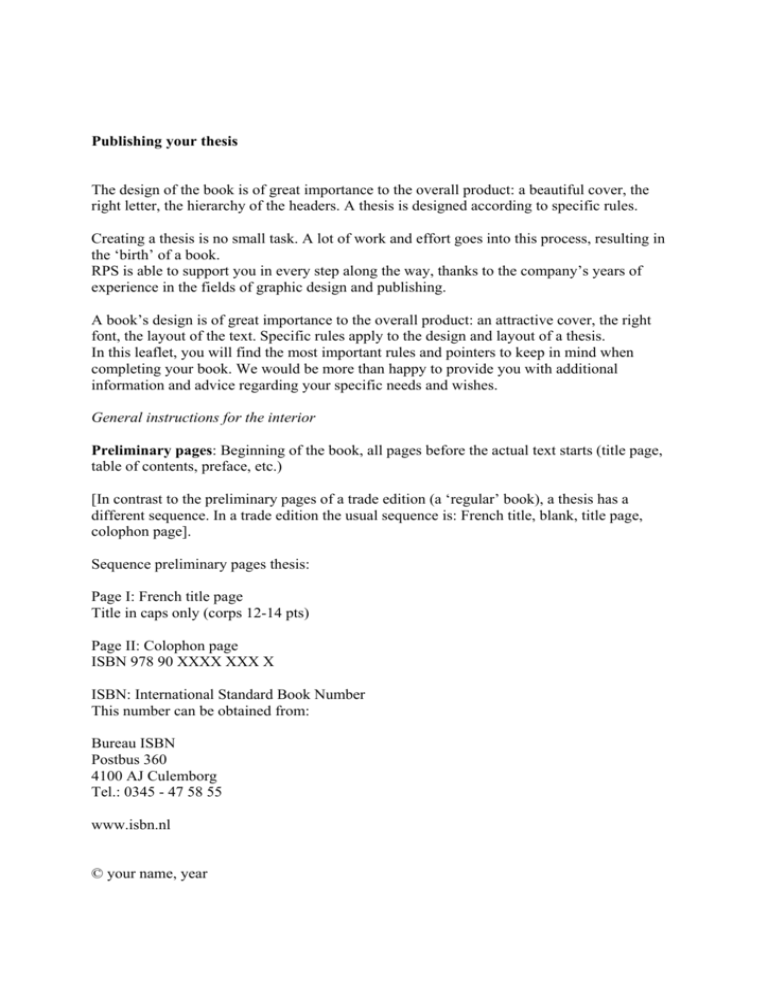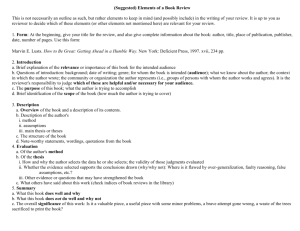
Publishing your thesis
The design of the book is of great importance to the overall product: a beautiful cover, the
right letter, the hierarchy of the headers. A thesis is designed according to specific rules.
Creating a thesis is no small task. A lot of work and effort goes into this process, resulting in
the ‘birth’ of a book.
RPS is able to support you in every step along the way, thanks to the company’s years of
experience in the fields of graphic design and publishing.
A book’s design is of great importance to the overall product: an attractive cover, the right
font, the layout of the text. Specific rules apply to the design and layout of a thesis.
In this leaflet, you will find the most important rules and pointers to keep in mind when
completing your book. We would be more than happy to provide you with additional
information and advice regarding your specific needs and wishes.
General instructions for the interior
Preliminary pages: Beginning of the book, all pages before the actual text starts (title page,
table of contents, preface, etc.)
[In contrast to the preliminary pages of a trade edition (a ‘regular’ book), a thesis has a
different sequence. In a trade edition the usual sequence is: French title, blank, title page,
colophon page].
Sequence preliminary pages thesis:
Page I: French title page
Title in caps only (corps 12-14 pts)
Page II: Colophon page
ISBN 978 90 XXXX XXX X
ISBN: International Standard Book Number
This number can be obtained from:
Bureau ISBN
Postbus 360
4100 AJ Culemborg
Tel.: 0345 - 47 58 55
www.isbn.nl
© your name, year
‘copyright clause’
Examples:
All rights reserved. Save exceptions stated by the law, no part of this publication may be
reproduced, stored in a retrieval system of any nature, or transmitted in any form or by any
means, electronic, mechanical, photocopying, recording or otherwise, included a complete or
partial transcription, without the prior written permission of the authors, application for which
should be addressed to author.
Dutch version:
Alle rechten voorbehouden. Niets uit deze opgave mag worden verveelvoudigd, opgeslagen in
een geautomatiseerd gegevensbestand of openbaar worden gemaakt, in enige vorm of op
enige wijze, zonder voorafgaande schriftelijke toestemming van de auteur.
Page III: Promotion page
Text according to instructions - See instructions you have received from your university.
Page IV: Doctoral committee page
Names of ‘promotors’ - also according to university instructions.
From page V you make the rules. However, there are unwritten rules that determine the
accessibility and readability of the book. Therefore:
Page V: Dedication (optional)
Page VI: Blank (optional)
Page VII: Table of contents
Page IX: Preface
Chapter 1 starts after these pages.
Please note: every chapter starts on an odd (right-hand) page.
The interior
Sequence
- The preliminary pages are not numbered. Numbering starts at the beginning of the actual
text.
- Every new part (from dedication to chapter) starts on a right-hand page. If needed, insert a
blank page on the left. This page is counted, but not numbered.
- Sequence: preface, introduction, chapter 1, 2, 3, etc., appendix(es), summary,
literature/bibliography, register, index, thank yous, curriculum vitae.
Design of the manuscript
Keep the design clean, logic and consistent.
Standard book size (thesis) is 16,5 x 24 cm
You determine the type area (area of the text printed on the page), but generally these are
good indications:
in Microsoft Word the page margins would be:
top: 2 cm - 3,5 cm
bottom: 2,5 cm
left: 3 cm
right: 2,5 cm
header: 1,25 cm - 2,5 cm
footer: 1,25 cm
The page number and possible headers fall outside these margins.
Letter
Preference goes to so-called serif types, for example the Times Roman or Garamond. Sansserif types, such as Helvetica or Arial, are less suited for longer texts.
Letter size
Preference goes to 12 pts. After reduction to 80% (done at the printers) this becomes 10 pts.
Notes 10 pts. after reduction this is 8 pts.
Line spacing
This depends on the letter. Try 1,2 as well as 1,3.
Headers (of chapters, paragraphs)
Be logic and consistent. Create a hierarchy.
Bold, italic type etc.: Avoid underlining. Be sparse with bold and italic.
Page numbering
Preferred is alternately at the left and right bottom of the page. On pages without text no page
number. Please note that blank pages do count in the numbering of the rest.
Handing in your completed and designed manuscript to us:
PDF
Very important when working with PDF files is using the right software. A lot of the free
available software is only useful for creating PDFs for screen use, and not for print (for
instance PDFwriter).
Our preference goes to Adobe Distiller.
If you hand in a trial chapter at an early stage, for us to check, it may avoid surprises in a later
stage.
Please be aware that we can hardly make any corrections in your PDF files. If there are any
mistakes/errors in your proof, you will have to hand in new PDF files.
Word / Text files
If you are not able to hand in PDF files, RPS can make them for you. In that case you send us
your Word files.
If you create your text files with Microsoft Word 2000 or higher, RPS is able to make perfect
PDF files of your text. When using earlier versions of MS Word or a different text editor,
please consult RPS.
Handing in photos digitally
When handing in photos digitally, please scan the original. Scan at 300 dpi and save
as .eps or .tiff file. Save black-and-white photos as grayscale. Colour photos as CMYK.
Bitmap files need to be at least 1200 dpi.
Of course we can scan your pictures for you.
Cover
If you hand in your cover digitally, you can use the above instructions. Please do consult RPS
in regard to the spine size and hand in one file: back, spine and front complete.
We can make a cover according to your wishes. Prices vary.
Handing in your manuscript for us to design
If you rather let someone else take care of the design of your book, we can do it for you.
Please contact us early, so that we can make a solid planning for making your book.
A six-week period before you have to hand in books at the Bureau Pedel is appreciated.
We need the digital text files and a complete print of your manuscript.
Prices of designing the book are variable, depending on the difficulty, tables, graphs, etc.
Technical completion of the book
Paper interior
Standard is 90 grs. matte mc paper for the interior. The reason for this is because it reads
easily and is good for printing photos and illustrations.
However you can choose from a variety of papers. If for instance you prefer a slightly tinted
paper, we recommend 90 grs. Biotop.
Cover
We print the covers on 240 grs. sulfaatkarton.
You have the option of matte or glossy laminate.
Cards and theses (stellingen)
The sizes of the cards are 10 x 15 cm and 6 x 23 cm.
Usually are created to match the cover of the book, but anything is possible.
Handing in the theses (stellingen): max. two A4 papers, same design as the interior, will be
reduced to 80%.
Cards and theses have to be handed in at the same time as the manuscript.
Time Schedule/Planning
From the Bureau Pedel you have received a date on which you need to hand in copies of your
thesis.
The printers need time to make a book out of your manuscript: text needs to be put on plate,
ink need to dry, the cover needs lamination, and the binder also requires time to finish the
book.
If you design the book yourself, and deliver us the manuscript in PDF file, we can produce a
good book in a relatively short time. But in order to have enough time to receive a proof and
still have time for corrections, the credo is simple: the earlier you hand in your files, the more
time (and ease of mind) you have to finish your book.
We need to receive your manuscript files and optional cards and theses at least three weeks
before the Pedel-date.
If you let us design your book, please deliver your files (and print-out) six weeks before the
Pedel-date.








